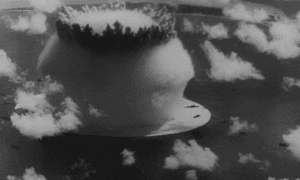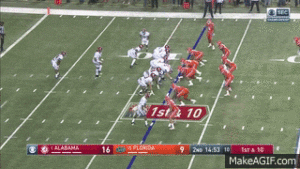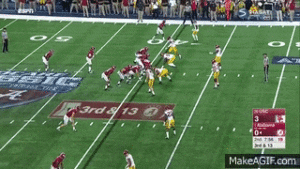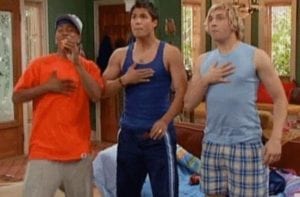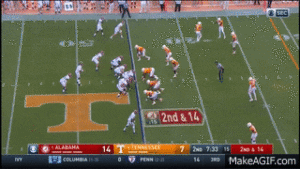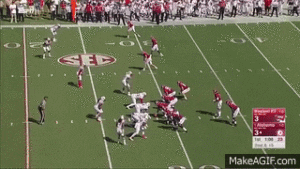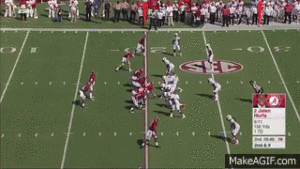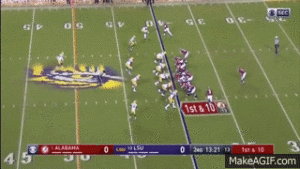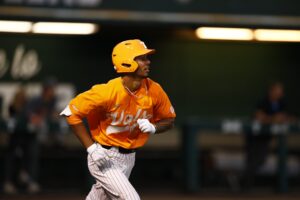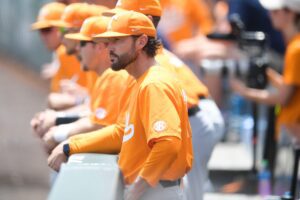The evolution of Jalen Hurts
Jalen Hurts has gone from little-known freshman to one win away from helping Alabama capture its fifth championship in eight seasons. Here’s an extensive look into Hurts’ performance and maturation throughout the season.
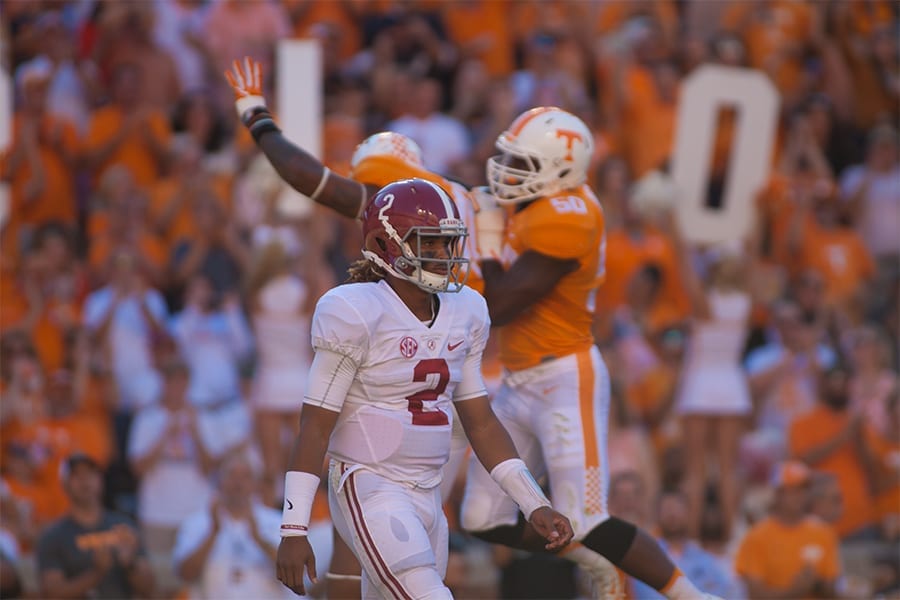
It’s easy to label Jalen Hurts as a product of the Alabama machine, a quarterback whose only demand is to not impede on yet another Crimson Tide championship conquest by limiting mistakes through the air, utilizing a stable of solid running backs and leaning on a historic defense when needed.
But minimizing Hurts’ contributions to merely a player enjoying the ride is unfair and inaccurate. Hurts isn’t driving the car, but he isn’t keeping Saban’s eyes off the championship path either by being a deterrent. Rather, the true freshman has added a dimension to Alabama’s offense it hasn’t experienced before in the Sith Saban era.
Before the season, if I told you the Crimson Tide would be 14-0 and heading to their fifth national championship in eight seasons after trudging through a brutal schedule that included road contests at Ole Miss, at Arkansas, at Tennessee and at LSU with a true freshman under center, you’d probably tar and feather me. Not only because the claim appears bogus (seriously, it’s Tennessee’s year!), but probably because you don’t want anybody saying anything positive about Alabama football, especially with a true freshman under center.
Yet, that’s exactly what’s transpired over the past four months. Hurts hasn’t been perfect —he’s barely scratching the surface when it comes to his potential— but the fact that he hasn’t been a thorn in Saban’s side is a testament to his play and maturation throughout the season.
You know what they say about thorns? Every rose has one. Guess where Alabama isn’t playing? The Rose Bowl. Guess who played in the Rose Bowl? USC. Guess who beat USC during opening weekend? Alabama.
You can’t make this stuff up.
Predictably, Hurts has his skeptics, and while there are multiple facets of his game that require fine tuning, it’s important to place certain circumstances in their proper perspective. This isn’t a senior quarterback we’re discussing, nor is it even a redshirt freshman. Remember, redshirt freshmen have a year to learn the offense, gain valuable reps in practice and become comfortable within their respective environment away from the spotlight. From the first game (on national television, no less) onward, Hurts hasn’t received any of those aforementioned luxuries. Instead, he’s had to learn while in the heat of battle in the most high-pressure position in all of college football, the quarterback in Tuscaloosa, while also facing the most athletic and highly skilled defenses in the country. Defenses that even give long-time starters fits.
Yet, despite Saban shuffling between Hurts and Blake Barnett over the first few games, ever since Week 5, Alabama’s offense has belonged to Hurts.
So, how has he performed?
Before deep diving into the statistics, here are a few disclaimers.
No. 1) I define “behind” throws as throws behind the line of scrimmage (duh, Captain Obvious), “short” throws as throws that travel 0 to 9 yards, “intermediate” throws as throws that travel 10 to 19 yards and “deep” throws as throws that travel 20 yards or more. I’m still waiting on a “Jamarcus Russell” throw, which is launching a pass 80 yards on your knees.
No. 2) When recording how Hurts performed under pressure, this is where the stats might differ from other sources. What I view as a pressure is different than what others view as pressure. Simply put, I view pressure as something that either forced Hurts to throw the ball away, forced Hurts to make a decision quicker than he normally would or a defender hitting Hurts almost immediately after the ball was released. What I don’t count as pressure is defensive ends circling around the ends and Hurts stepping up in the pocket to make a clean throw. That’s just exceptional pocket maneuverability. Also, just because Verne Lunquidst said the word pressure in the broadcast, doesn’t mean it’s true. That guy was pretty bad at his job, but he’s adorable, so whatever.
No. 3) My completion percentage won’t always reflect the actual completion percentage. For example, let’s say Hurts went 1-of-3 on one drive, but his receiver dropped a pass and he threw one ball away. While that completion percentage is technically 33 percent, I list that as 100 percent because a drop shouldn’t count against Hurts, and neither should a throwaway. So, I’ll actually refer to it as accuracy percentage instead of completion percentage.
No. 4) I didn’t count the game against Chatanooga for a couple of reasons. First, I wasn’t able to watch Hurts’ performance during Alabama’s first two drives of that game due to lack of footage. More importantly, I’m more interesting in seeing Hurts’ areas of strengths and weaknesses against FBS defenses. Sorry, Chatanooga, you have a great aquarium, but you don’t matter here. #MocLivesDontMatter. And no, I didn’t put an apostrophe with “don’t” in the hashtag because that would break off the hashtag.
No. 5) Click on the GIFs.
No. 6) Rain Drop, Drop Top, the hate on Jalen Hurts needs to Stop Stop.
Okay, here are the stats:
Statistical breakdown of Hurts’ throws
- Behind: 106-111, 791 yards, 7 TD, INT
- Short: 58-79, 478 yards, 6 TD, 2 INT
- Intermediate: 31-56, 601 yards, 5 TD, 2 INT
- Deep: 17-47, 669 yards, TD, 2 INT
- Pressure: 28-80, 294 yards, TD, 5 INT
It’s apparent by the raw statistics, as well as the tape, that Hurts does most of his damage from behind the line of scrimmage, which means Alabama’s skill position players are actually doing the brunt of the work. This offensive strategy has developed over the course of the season, as former offensive coordinator Lane Kiffin essentially put the training wheels on Hurts when it came to downfield throws early on. Remember, Hurts’ first touchdown pass was a gorgeous, 39-yard rocket while rolling to his right during the Crimson Tide’s 52-6 obliteration of USC. Against Western Kentucky, Hurts’ first career start, he threw 11 deep passes, completing three of them for 111 yards. However, Hurts actually had an accuracy percentage of 45 percent, as his receivers dropped two touchdown passes.
Since then, Hurts has averaged only 2.8 deep passes per game.
It’s been a perplexing development, but one that’s understandable. Hurts not only possesses the arm talent to essentially make every throw, but it’s not as if he blindly throws the ball into triple coverage down the field like Brett Favre. At the same time, it’s perfectly reasonable for Kiffin to limit Hurts’ downfield shots against the ball hawks lurking in SEC defensive backfields, who are akin to ruthless, savage, middle-aged moms Black Friday shopping.
So instead, Kiffin has leaned on three types of throws to place Hurts in comfortable situations and potentially open up more vertical routes.
The first throw is a simple jet sweep where Hurts lightly tosses the ball as soon as he receives the snap to a motioning receiver. This play has been utilized numerous times throughout the season and is fairly obvious for a defense to sniff out due to the formation, but it has somehow remained effective.
Next, Kiffin loves to call another motion play where a tight end (normally OJ Howard) begins to motion behind the line of scrimmage just before the snap of the ball. If Hurts, who is in the shotgun with a running back beside him, sees a defender commit to stopping the run, he’ll fake the handoff, slightly roll to his right and deliver a soft floater to his tight end.
Lastly, Alabama likes to roll Hurts outside of the pocket. Sometimes, they’ll have him execute a delayed fake handoff followed immediately by a rollout. Other times, Hurts will begin rolling as soon as he receives the snap. Again, Hurts has the natural arm talent to deliver rockets on the move, but he also has the legs to scramble and the awareness to throw the ball harmlessly out of bounds when there’s nothing available.
There are also plenty of tunnel screens and other variations of the short passing game Kiffin loved to implement with Hurts. And when I say Kiffin loved the behind-the-line/short passing game, I mean the way he loves to exit his coaching jobs in a blaze of glory. He also loved motioning receivers, so I guess you can say Alabama are the boys in motion.
Against Auburn—one of the elite defenses in college football—Kiffin called an assortment of short-yardage passing plays, as Hurts threw 20 of his 36 pass attempts behind the line of scrimmage.
That’s been the theme for Alabama’s offense this season: Get the ball out of Hurts’ hands quickly and let the athletes be athletes in the open field. That isn’t to say Hurts hasn’t blended the short passing game with the long ball at all this season. At various points, he’s done so quite efficiently, with his most balanced throwing performance coming against Arkansas.
Statistical Breakdown vs. Arkansas
- Behind: 4-of-4, 82 yards, TD (4 accurate throws)
- Short: 4-of-4, 27 yards, TD (4 accurate throws)
- Intermediate: 3-of-3, 45 yards (3 accurate throws)
- Deep: 2-of-4, 109 yards (3 accurate throws, 1 inaccurate throw)
- Pressure: 2-of-5, 24 yards, INT (3 accurate throws, 1 throwaway, 1 pass hit as thrown)
Hurts was essentially flawless against the Razorbacks, throwing only one inaccurate pass the entire game.
However, my vote for Hurts’ best overall performance of the season given the circumstances was his showing on the road against Ole Miss. In only his second career start, Hurts headed into a hostile environment against a team that frankly had Alabama’s number over the previous two seasons. This situation normally doesn’t bode well for a true freshman quarterback, especially once the Rebels took an early 24-3 lead after a blindside sack caused Hurts to fumble, which Ole Miss scooped up and returned for a touchdown.
Impressively, Hurts responded the way an Alabama player only knows how to, and that’s with glacial temperatures within the tubes forming part of the blood circulation system of the body that in most cases carry oxygen-depleted blood toward the heart. On the very next possession, Hurts redeemed himself with a beautiful, 22-yard downfield strike to Calvin Ridley before scampering for 22 yards on the ground himself, setting up a six-yard touchdown to bring Alabama within two scores. Hurts only threw for 158 yards, but added 146 crucial yards on the ground as well.
Statistical breakdown at Ole Miss
- Behind: 12-of-13, 17 yards (yes, it says 17 yards. That happened. Also, 12 accurate throws, 1 inaccurate throw).
- Short: 2-of-5, 9 yards (4 accurate throws, 1 inaccurate throw, 2 drops)
- Intermediate: 4-of-8, 87 yards (4 accurate throws, 4 inaccurate throws)
- Deep: 1-of-3, 45 yards (1 accurate throw, 2 inaccurate throws)
- Pressure: 6-of-10, 61 yards (7 accurate throws, 1 inaccurate throw, 2 throwaways)
Hurts’ performance under pressure against Ole Miss was particularly impressive, posting an accuracy percentage of 88 percent, which contradicts the panning of Hurts’ performance under pressure he’s experienced all season long. The raw statistics do side with his detractors, as Hurts is only completing 35 percent of his passes under duress with a pitiful TD-INT ration of 1:5.
But a deeper look into the numbers suggests that Hurts deserves more credit. For starters, two of his five interceptions don’t negatively affect the quality of his performance. One came off a Hail Mary attempt against Texas A&M before halftime, which isn’t of any consequence since a Hail Mary is a low percentage throw anyway. The second interception came against Arkansas on a play where Hurts was hit as soon as he threw the ball, thus altering its intended course.
You also have to factor that a key reason why Hurts’ completion percentage under pressure is so low is because he often opts to take the L and sail passes out of bounds, a surprising quality for a quarterback to possess at such an early stage. It’s a trait that’s often taken for granted by fans and forgotten by even some of the most experienced quarterbacks in college football. At times, you’ll see quarterbacks extend plays at any cost and throw ill-advised passes downfield to avoid either getting sacked or willingly lowering their completion percentage. Yet, it’s seemingly been engrained in Hurts’ mind by Saban (and maybe Kiffin. Maybe he actually does help people) that it’s okay to lose battles, as long as it doesn’t jeopardize the outcome of the war.
Because if you jeopardize the outcome of a war involving Saban, he’ll more than likely make you and your family prisoners of war, where the punishment is him playing his secretly recorded studio album of Michael Jackson and Eagles covers while you’re forced to watch only LSU’s offense in the 2011 National Championship. Welcome to the Hotel Tuscaloosa.
Any who, if all 24 of Hurts’ throwaways in the face of pressure are removed, his measly completion percentage of 35 percent reveals a significantly improved accuracy percentage of 61 percent. It’s like if you take away all of Deshaun Watson’s interceptions, he might actually be a good quarterback, but he isn’t, and this is a poor analogy.
While one aspect of Hurts’ knack for throwing the ball away is mental—he understands when there’s a point of no return in any given play—the other part is physical, and it’s the elephant in the room: He’s mobile, the added dimension I mentioned earlier that makes him an integral part of the Crimson Tide’s current and future success.
We all know the typical quarterback during the Saban era: A nameless, faceless pocket passer (unless you date Katherine Webb and Brent Musberger is peaking around the corner) who reaps the benefits of Alabama’s roster stacked with NFL talent. It’s no different for Hurts, but add hot wheels to the hum tater, then you have an offense so dynamic you might lure Mike D’Antoni to college football. Watch out, Saban.
While this potentially dynamic offense hasn’t fully materialized yet in Tuscaloosa due to Hurts’ current limitations as a passer, the statistics on the ground are still impressive, as he’s rushed for 891 yards and 12 touchdowns.
However, it’s more than the numbers. It’s his style. Hurts accelerates so effortlessly that it catches every spectator off guard, including players.
Hey, I was at that game! When Hurts started running, my thought process was, “Okay, when he gets out of bounds, I’ll apply sun screen so I don’t fry. Oh, he’s still going. Well, I’ll just wait a little bit, don’t want to miss anything, but he’ll be out of bounds soon. Oh…he’s still running. Now that I think about it, let me start preparing my reaching into my pocket and grabbing the sun screen. That way, as soon as he gets out of bounds, I can immediately pop off the cap and apply the sun screen. I’ll start with my arms…oh, he’s still going, wow…then I’ll work my way to my legs. Crap, I’m wearing jeans, so that doesn’t make sense. I might ask the guy in front of me if he wants to swap pants, that why I can have the satisfaction of applying sun screen to my legs. Is he 20 yards away from scoring? Man, he can fly. Lastly, I’ll apply the sun screen to my face, but ask my friend to make sure I’ve rubbed it in my skin all the way. I don’t want to embarrass myself by walking around with leftover sun screen on my face. Wait…did he just score? I don’t care about the sun screen anymore. I want to burn.”
Hurts is not only deceptively fast—and I mean that in the most non Blaine Gabbert way possible—but he’s also remarkably patient, shifty and avoids punishment by either navigating his way out of bounds or tensing up while falling down to avoid unnecessary contact. Essentially, he’s the anti-Josh Dobbs, a quarterback who warmly embraces an unnecessary amount of contact.
Needless to say, there’s a lot to love about Hurts. He has all the physical and mental tools to become one of the nation’s top quarterbacks, if not the top quarterback. To kind of quote Jay Z, “Yeah, I’m talkin O’Brien. Yeah, I’m talkin Maxwell. Yeah, I’m talkin Heisman.” Ooh, kinda rhymed there, didn’t I?
Oh, and just in case you wanted to know the original lyric:
From the song “Clique” off of the mediocre compilation album from G.O.O.D. Music entitled “Cruel Summer”: “Yeah I’m talkin Ye’, Yeah I’m talkin Rih’, Yeah I’m talkin B.”
It’s just a matter of development at this point, which is normal for any quarterback only 18 years of age. But on the bright side for Steve Sarkishian, this isn’t a massive project. Hurts has 14 games of valuable experience under his belt and has displayed surprising accuracy at all depths on the field for such a young quarterback.
Accuracy Percentage Breakdown
- Behind: 96 percent (107-of-111)
- Short: 82 percent (65-of-79)
- Intermediate: 61 percent (34-of-56)
- Deep: 43 percent (20-of-46)
Hot take: The farther away the target is, the harder it is to complete a pass to them.
Need proof?
Happy?
While Hurts can improve on his downfield accuracy, he’s displayed flashes of brilliance with dimes like this:
Of course, that pass accounted for roughly 42.6 percent of Hurts’ total passing yards against LSU. For my non-math majors out there, as well as those who don’t want to google the box score, that means Hurts threw for only 107 yards against the Tigers, making that throw 52 yards in length. Therein lies one of Hurts’ central issues: Performance against elite defenses.
It’s preposterous to expect Hurts to put up Tim Tebow-esque numbers on a week-by-week basis, but against the upper-echelon defenses—LSU, Auburn, Florida and Washington—there was a clear drop-off in quality of play.
Kiffin’s simplification of Alabama’s offense accomplished its goals against weaker opponents, but against more disciplined defenses where the pass rush penetrates the backfield a little quicker and the coverage in the secondary is a little tighter, the simplicity in the passing game yielded pedestrian results.
At this stage in his development, Hurts simply isn’t ready to dissect a complicated defense. Wonder why Kiffin’s play calling was so conservative against the Huskies in the College Football Playoff Semi-Final? Because Washington’s defense would’ve forced Hurts into uncomfortable territory. So while Saban was clearly unamused by Kiffin’s decisions, those decisions were based on evidence.
Statistical Breakdown at LSU
- Behind: 6-of-8, 3 yards (7 accurate throws, 1 inaccurate throw, 1 drop)
- Short: 2-of-2, 30 yards (2 accurate throws)
- Intermediate: 1-2, 21 yards, INT (1 accurate throw, 1 inaccurate throw)
- Deep: 1-3, 52 yards (1 accurate, 1 inaccurate)
- Pressure: 1-5, -2 yards, INT (3 inaccurate, 1 tipped pass, 1 throwaway)
Statistical Breakdown vs Washington
- Behind: 2-of-2, 0 yards (2 accurate throws)
- Short: 2-of-3, 15 yards (2 accurate throws, 1 inaccurate throw)
- Intermediate: 3-of-6, 42 yards (4 accurate throws, 2 inaccurate throws, 1 drop)
- Deep: 0-of-1, 0 yards (1 inaccurate throw)
- Pressure: 0-of-3, 0 yards (1 inaccurate throw, 2 throwaways)
To Hurts’ credit, he never ventures outside of the system and plays hero ball. He’s aware of his limitations, as well as the immense talent around him. Rather than force a deep ball down the field in a tire-wide window, he’ll go to his check down and let them work their magic. If the game plan calls for Hurts to hand the ball off to Bo Scarborough and Damien Harris 20 times each, he’ll gladly do so.
That’s exactly why Hurts is a perfect fit for Saban. His demeanor under pressure is extraordinarily calm for a true freshman. Maybe that’s due to Saban chewing Hurts out so much that he no longer has emotions, but while he may not be a Heisman contender and he might not face the same level of responsibility other quarterbacks experienced this season, more credit should be given to Hurts considering the circumstances and borderline unrealistic expectations thrust upon him.
Edited by Nathan Odom
Featured image by Sumner Gilliam
Follow me @DavidJBradford1 on Twitter, email me at dbradfo2@vols.utk.edu for any questions.

